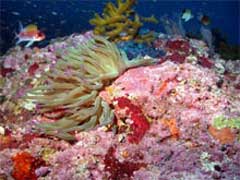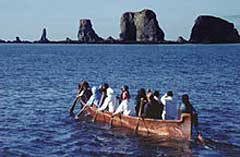|
|
Authorizing Mandate
In response, NOAA created the Office of Ocean Exploration (OOE) to lead the effort. OOE is a major program office within NOAA's Office of Oceanic and Atmospheric Research. OOE coordinates the agency’s exploration efforts and facilitates research expeditions. Most cruises to date have been multidisciplinary endeavors conducted in conjunction with such organizations as Woods Hole Oceanographic Institution, Harbor Branch Oceanographic Institution, and many academic institutions. OOE partners with several NOAA offices and programs, including the National Marine Sanctuary Program. NOAA's National Ocean Service (NOS) helps to plan explorations that take place within the nation's 13 national marine sanctuaries and one ecological research reserve. In addition, NOS directs and maintains the official Web site for these explorations, NOAA Ocean Explorer. This offering serves as a public archive of the exploration program, chronicling many of the missions with detailed daily logs, informative background essays, and rich multimedia offerings. It also offers over 130 hands-on, standards-based lesson plans and a curriculum based on the explorations.
Ocean Exploration in the National Ocean Service
In 2001 and 2002, multidisciplinary teams traveled through the Gulf of Mexico and up the Atlantic coast to explore protected and unprotected deep water coral reefs and hard-bottom communities. This mission passed through the Flower Garden Banks National Marine Sanctuary off the coast of Texas, the Florida Keys National Marine Sanctuary at the southern tip of Florida, and Gray’s Reef National Marine Sanctuary off of Georgia. On the west coast, explorers have documented the cultural links of the Northwest Coast Native Americans and First Nations to the marine environment in the Olympic Coast National Marine Sanctuary off of Washington. Teams also conducted research, exploration, and monitoring along the California coastline in Cordell Bank, Gulf of the Farallones, Monterey Bay, and Channel Islands national marine sanctuaries. (top)
|
|
||||||||||||||||||||||||||||
- NOS Program Offices
- Center for Operational Oceanographic Products and Services
- National Centers for Coastal Ocean Science
- NOAA Coastal Services Center
- National Geodetic Survey
- Office of Coast Survey
- Office of National Marine Sanctuaries
- Office of Ocean and Coastal Resource Management
- Office of Response and Restoration

Revised December 17, 2007
| Questions, Comments? Contact Us | Report
Error | Disclaimer | About
the Site | User Survey
National Oceanic and Atmospheric
Administration | U.S.
Department of Commerce | USA.gov
http://oceanservice.noaa.gov/topics/oceans/oceanex/welcome.html




